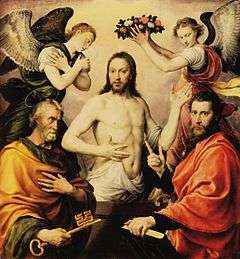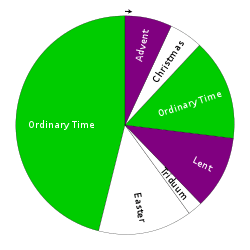Feast of Saints Peter and Paul
The Feast of Saints Peter and Paul or Solemnity of Saints Peter and Paul is a liturgical feast in honour of the martyrdom in Rome of the apostles Saint Peter and Saint Paul, which is observed on 29 June. The celebration is of ancient Christian origin, the date selected being the anniversary of either their death or the translation of their relics.[2]
| Feast of Saints Peter and Paul | |
|---|---|
 | |
| Official name | Feast of Saints Peter and Paul, Solemnity of Saints Peter and Paul |
| Observed by | Eastern Orthodox Church Catholic Church Lutheran Church Oriental Orthodoxy Rome[1] Ticino, Switzerland Malta |
| Celebrations | Mass |
| Date | 29 June |
| Next time | 29 June 2021 |
| Frequency | Annual |
Eastern Christianity
For Eastern Orthodox and some Eastern Catholic Christians this feast also marks the end of the Apostles' Fast (which began on the Monday following All Saints' Sunday, i.e., the second Monday after Pentecost). It is considered a day of recommended attendance, whereon one should attend the All-Night Vigil (or at least Vespers) on the eve, and the Divine Liturgy on the morning of the feast (there are, however, no "Days of Obligation" in the Eastern Church). In the Julian calendar, 29 June falls on the Gregorian calendar date of 12 July from 1900 - 2099, inclusive.
In the Russian Orthodox tradition, Macarius of Unzha's Miracle of the Moose is said to have occurred during the Apostles' Fast and the Feast of Saints Peter and Paul that followed it.
Western Christian tradition
In the General Roman Calendar, the celebration is a solemnity. In earlier editions, it was ranked as a Double (Tridentine Calendar), Double of the First Class (e.g., General Roman Calendar of 1954), or First-Class Feast (General Roman Calendar of 1960). Prior to the liturgical reforms of Pope Pius XII, this feast was followed by a common octave.
It is a holy day of obligation in the Latin Church, although individual conferences of bishops can suppress the obligation.[3] In England, Scotland and Wales the feast is observed as a holy day of obligation while in the United States and Canada, it is not. The Feast ceased being a Holy Day of Obligation in the United States in 1840.[4] In Malta it is a public holiday and in Maltese known as L-Imnarja.
In 1577 Jan Rubens named his son Peter Paul, because he was born during the office of vespers of this day.[5]
On this feast, newly created metropolitan archbishops receive from the pope the primary symbol of their office, the pallium.
The Anglican Communion celebrates the Feast of St Peter and St Paul on 29th June as a lesser festival.
The Lutheran Churches celebrate 29 June as the Feast of Saints Peter and Paul; it holds the rank of a Lesser Festival.[6]
The Voice of the Martyrs, a non-governmental organization that aids persecuted Christians, has designated 29 June as the "Day of the Christian Martyr", in honour of the martyrdom of Saints Peter and Paul, as well as all martyrs for the Christian faith.[7]
Oriental Orthodox tradition
The Coptic Orthodox Church and the Ethiopian Orthodox Tewahedo Church are also celebrated on the day 5 Epip which is also the end of the fast of the apostles.[8]
Spiritual Christian tradition
Although the Canadian Doukhobors, a Spiritual Christian denomination, do not venerate saints, the Feast of St. Peter and St. Paul has traditionally been a day of celebration for them. Since 1895, it has acquired a new significance as a commemoration of the "Burning of the Arms", the Doukhobors' destruction of their weapons, as a symbol of their refusal to participate in government-sponsored killing.[9] It is celebrated now by their descendants as simply "Peter's Day" (Russian: Petro den.), sometimes referred to as the "Doukhobor Peace Day".[10][11]
In the region of Southeastern Italy called Puglia, the celebration of the Saints is connected to folkloristic Taranta dance. Folklore discusses people dancing after a spider's bite. The specific spider breed referenced is the Tarantula.
According to folklore, people started a liberatory and compulsive dance and asked the saints to set them free from the sin and the curse. The main city where this happened is Galatina, where the basilica of Saint Peter and Paul is located.
Public holiday
The feast is observed in Rome because St. Paul and St. Peter are patron saints of the Eternal City. It is also a public holiday of the Canton of Ticino, Switzerland, as well as parts of the Swiss cantons of Lucerne and Graubünden. It is a public holiday in Peru, in Malta, and in various municipalities of the Philippines.
See also
- Feast of Saints Peter and Paul, patron saint archive
- Golowan Festival
- Incident at Antioch, a dispute between Peter and Paul
- International Day of Prayer for the Persecuted Church
- St Peter's Eve
References
- "Festa di San Pietro e Paolo a Roma". www.regioni-italiane.com.
- The Catholic Encyclopedia, Volume XI (Robert Appleton Company, New York, 1911), s.v. "St. Paul", accessed 4 June 2007.
- Codex Iuris Canonici (1983), canon 1246.
- "American Catholic Quarterly Review, Volume 11". Retrieved 13 June 2020.
- Historische levensbeschryving van P.P. Rubens Door Jean Francois Marie Michel p.14
- "Feasts and Festivals". Lutheran Church--Missouri Synod. Retrieved 29 June 2019.
- "The Day of the Christian Martyr - 29 June 2019". Release International. 29 June 2019. Retrieved 29 June 2019.
- https://st-takla.org/Full-Free-Coptic-Books/Synaxarium-or-Synaxarion/11-Abeeb/05-Abeeb.html
- Tarasoff, Koozma J. "Historic 1895 Burning of Guns: descriptions, selections and translations". Spirit-Wrestlers.com. Retrieved 23 June 2016.
- Tarasoff, Koozma J. The Doukhobor Peace Day, May 4, 2002
- Tarasoff, Koozma J., with Andrei Conovaloff. "Historic 1895 Burning of Guns descriptions, selections and translations". Spirit Wrestlers. Spirit Wrestlers Publishing. Retrieved 20 May 2018.
External links
| Wikimedia Commons has media related to Feast of Saints Peter and Paul. |
- The Holy Glorious and All-Praised Leader of the Apostles, Peter & Paul Icon and Synaxarion of the Feast (Orthodox)
